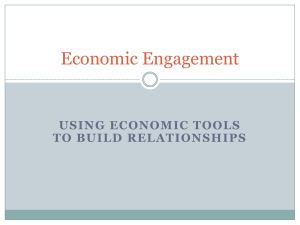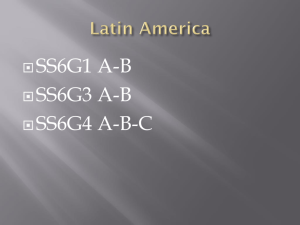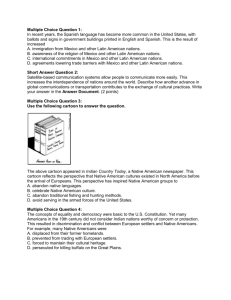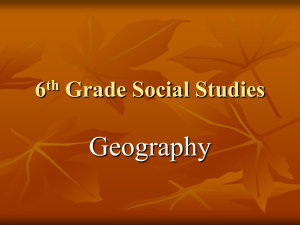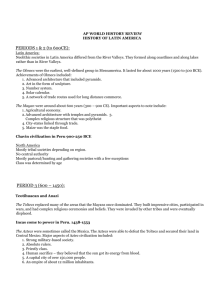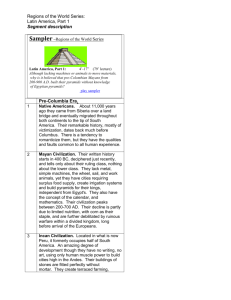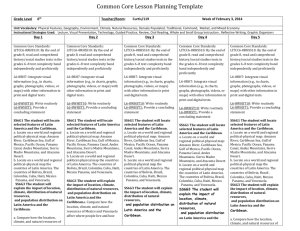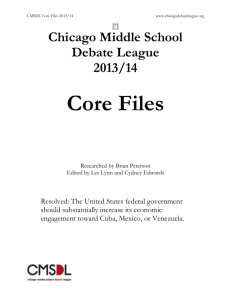Latin America Unit Review
advertisement
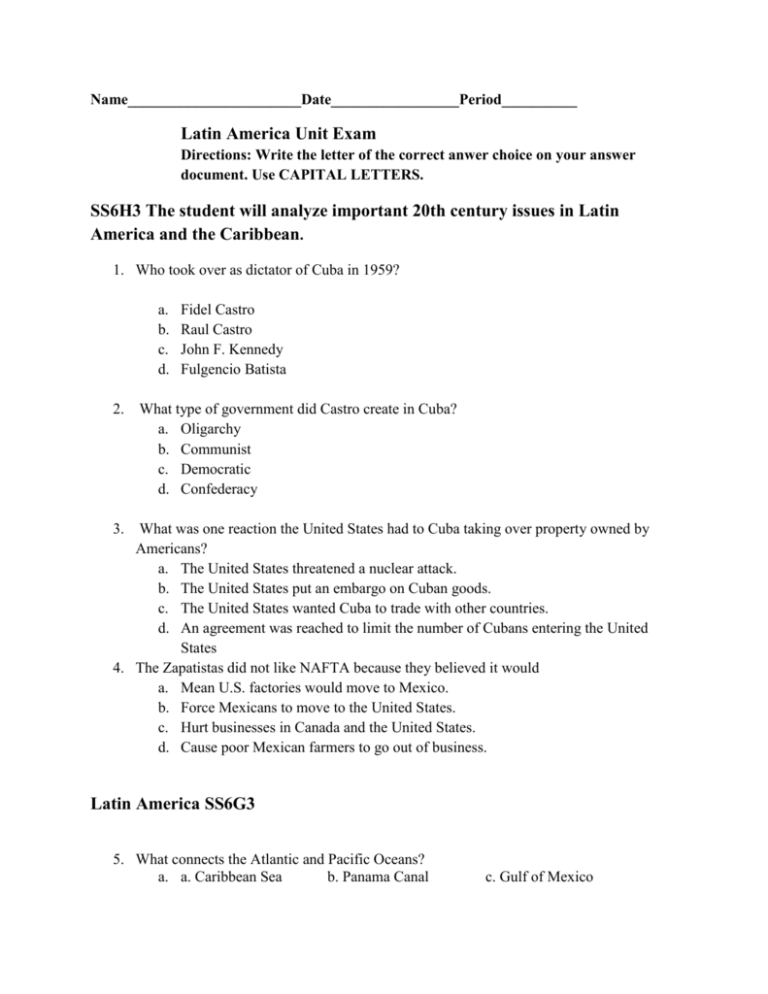
Name_______________________Date_________________Period__________ Latin America Unit Exam Directions: Write the letter of the correct anwer choice on your answer document. Use CAPITAL LETTERS. SS6H3 The student will analyze important 20th century issues in Latin America and the Caribbean. 1. Who took over as dictator of Cuba in 1959? a. b. c. d. Fidel Castro Raul Castro John F. Kennedy Fulgencio Batista 2. What type of government did Castro create in Cuba? a. Oligarchy b. Communist c. Democratic d. Confederacy 3. What was one reaction the United States had to Cuba taking over property owned by Americans? a. The United States threatened a nuclear attack. b. The United States put an embargo on Cuban goods. c. The United States wanted Cuba to trade with other countries. d. An agreement was reached to limit the number of Cubans entering the United States 4. The Zapatistas did not like NAFTA because they believed it would a. Mean U.S. factories would move to Mexico. b. Force Mexicans to move to the United States. c. Hurt businesses in Canada and the United States. d. Cause poor Mexican farmers to go out of business. Latin America SS6G3 5. What connects the Atlantic and Pacific Oceans? a. a. Caribbean Sea b. Panama Canal c. Gulf of Mexico 6. What is the mountain range in Mexico? a. a. Sierra Madre b. Andes Mountains c. Atacama Desert 7. What is the largest country in South America? a. a. Bolivia b. Colombia c. Brazil 8. What country shares a border with the United States? a. a. Mexico b. Haiti c. Florida 9. One of the largest urban areas in the world is centered around: a. a. Mexico City b. Venezuela c. Panama SS6H1 and SS6H2 Latin America Cultural Influence 10. Who conquered the Aztecs? a. a. Hernan Cortes 11. Who conquered the Incas? a. a. Hernan Cortes Columbus b. Montezuma c. Simon Bolivar b. Francisco Pizzaro c. Christopher 12. What helped Spanish explorers defeat the Incas and Aztecs? a. a. Smallpox/disease b. Sugar Cane c. Tropical Climate 13. Who brought independence to Columbia, Panama, Venezuela, Ecuador, Peru, and Bolivia? a. a. Simon Bolivar b. Toussaint L’Ouverture c. Miguel Hidalgo 14. What Catholic priest started the independence movement in Mexico? a. a. Miguel Hidalgo b. Simon Bolivar c. Toussaint L’Ouverture SS6G4 b. Literacy Rates in Latin America 15. Which is often an effect of a high literacy rate? a. A higher illiteracy rate b. Lower education b. d. A higher standard of living c. A lower standard of living 16. Why do some countries have higher literacy rates for boys than for girls? a. Boys enjoy learning to read and write more than girls do b. Girls enjoy learning to read and write more than boys do c. Some cultures believe that it is not important for girls to learn to read and write as it is for boys. d. Some cultures believe that it is inot important for boys to learn to read and write as it is for girls. SS6G4 a.Blending of Ethnic Groups in Latin America and the Caribbean 17. In Latin America and the Caribbean, people with which ethnic background often have better jobs and more money? a. African b. European c. Mestizo d. Native American SS6G4b. Languages of Latin America 18. What are the two primary languaages of Latin America? a. English and French b. French and Spanish c. Portuguese and English b. d. Spanish and Portuguese SS6G1 Latin America Geography 1 2 3 8 7 4 5 6 a. Use the map above. Choose the best answer for questions 20-27. 19. Which physical feature is found near the “1” on the map? 20. Which physical feature is found near the “6” on the map? 21. At which number on the map is the Caribbean Sea? 22. The Amazon River is found, at which number on the map? 23. Which physical feature is found near the “5” on the map? 24. Which physical feature is found near the “3” on the map? 25. Which political feature is found near the “7” on the map? 26. Which poltical feature is found near the “8” on the map? SS6CG1 a Describe the way government systems distribute power 27. In a confederation government power lies with…… a. The people b. The central government b. A constitution b. c. A constitution. d. The governments of member countries 28. Which type of government divides power between the central government and smaller units like states? a. a. Confederation b. Federal c. Toltalitarian d. Unitary SS6CG1 b. How governments determine citizen participation 29. Which form of government puts the power of the government in a single person? a. Autocracy b. Direct Democracy c. Oligarchy d. Representative Democracy SS6CG1 c Two predominant forms of democratic governments 30. A presidential democracy is used in which country? a. Australia b. Canada c. Mexico d. United Kingdom SS6CG2 a The structures of national governments in Latin America: Brazil, Mexico, Cuba 31. What type of government exists in Brazil ? a. Communist b. Monarachy c. Parliamentary Democracy d. Presidential Democracy SS6G3 a Compare the location, climate and natural resources of Mexico and Venezuela. 32. What metal is mined more in Mexico than anywhere else? a. Copper b. Iron c. Lead d. Silver SS6G2 a Discuss environmental issues in Latin America 33. The world gets about 20 percent of which resource from the Amazon Rain Forest? a. Medicine b. Oxygen c. Rubber d. Soybeans SS6E1 Analyze Different Economic Systems 34. Customs and habits are most important in which type of economy ? a. Command b. Mixed c. Market d. Traditional SS6E1 c Contrast basic types of Economic Systems 35. Which country has the least freedom to do business? a. Brazil b. Canada c. Cuba d. about the same in each Essay On white paper Discuss in detail environmental issues in Latin America. Be sure to include pollution; deforestation, as well as oil and oxygen production. Discuss why the government of Venezuela might not want to stop oil production. ( 15 points) Compare the location ,climate and natural resources of Mexico and Venezuela? Include farming, mining, trade and oil economy. (10 points) Compare the location, climate, and natural resources of Brazil and Cuba. Include where people live and why they live there. Include major exports and which countries received assistance from other nations. Compare the size and population of Brazil and Cuba. (15 points) Describe the influence of the Spanish and Portuguese on the languages and religions of Latin America. (10 points) Describe the impact of European contact on Latin America. Include your description of the encounter and consequences of the conflict between the Spanish and the Aztecs and Incas and the role of Cortes, Montezuma, Pizatto and Atahualpa. (25 points) Explain the impact of the Columbia Exchange on Latin America and Europe in terms of the decline of the native people, population, agriculture, and introduction of the horse. ( 25 points)
